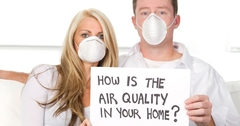
The quality of the air we breathe in our homes directly impacts our health and overall well-being. While concerns about indoor air quality often revolve around pollutants and allergens, an often underestimated and unpleasant consequence of poor air quality is the persistence of odors. Lingering smells can not only affect our comfort but also serve as indicators of underlying issues within our indoor environments. In this blog post, we'll explore the intriguing link between poor indoor air quality and persistent odors, shedding light on the potential causes and offering solutions for a fresher living space.
Understanding Indoor Odors
Common Culprits
Indoor odors can stem from various sources, including cooking, pets, smoking, household products, and even building materials. While some odors may be transient, others persist and become more noticeable over time, signaling a potential connection to indoor air quality issues.
Indoor Pollutants
Persistent odors often accompany the presence of indoor pollutants. Mold, mildew, volatile organic compounds (VOCs), and allergens can contribute to both the air quality and the presence of lingering smells. Addressing the root causes of these pollutants is essential for eliminating persistent odors.
The Nexus Between Poor Indoor Air Quality and Lingering Odors
Inadequate Ventilation
Insufficient ventilation is a common contributor to both poor air quality and persistent odors. When indoor spaces lack proper ventilation, pollutants accumulate, and odors become trapped, creating an unpleasant and stale atmosphere.
Moisture and Mold
Excess moisture in the air can lead to the growth of mold and mildew, which not only poses health risks but also emits musty odors. Mold spores in the air can exacerbate respiratory issues and contribute to the persistence of unpleasant smells.
Household Products and VOCs
Certain household products, such as paints, cleaning supplies, and air fresheners, release VOCs into the air. While these products may temporarily mask odors, they can contribute to poor air quality and create a mixture of chemical smells that linger.
Identifying and Addressing Odor Sources
-
Comprehensive Cleaning:
Thoroughly clean and sanitize areas prone to odors, such as kitchens, bathrooms, and pet areas. Regular cleaning not only removes existing smells but also helps prevent the buildup of pollutants and allergens. -
Effective Ventilation Systems:
Invest in and maintain efficient ventilation systems to ensure proper air circulation throughout your home. This includes using exhaust fans, opening windows when possible, and considering the installation of energy recovery ventilators (ERVs) to exchange stale indoor air with fresh outdoor air. -
Humidity Control:
Keep indoor humidity levels in check to prevent mold growth. Use dehumidifiers in damp areas, fix any water leaks promptly, and ensure proper ventilation to reduce moisture accumulation. -
Natural Odor Absorbers:
Consider using natural odor absorbers, such as baking soda, activated charcoal, or indoor plants, to help neutralize and eliminate odors. These eco-friendly options can be strategically placed in areas with persistent smells. -
Professional Air Quality Assessment:
If odors persist despite efforts to address common sources, consider seeking professional assistance for an indoor air quality assessment. Professionals can identify hidden pollutants and provide targeted solutions to improve air quality.
Preventing Persistent Odors Through Proactive Measures
Mindful Material Choices
When renovating or furnishing your home, choose low-VOC or VOC-free materials to minimize the release of harmful chemicals into the air. This not only promotes better air quality but also helps prevent the onset of persistent odors.
Regular HVAC Maintenance
Schedule regular maintenance for your heating, ventilation, and air conditioning (HVAC) system to ensure proper filtration and ventilation. Clean or replace air filters as recommended, and address any issues promptly to prevent the buildup of pollutants.
Adequate Ventilation During Activities
When engaging in activities that release odors or pollutants, such as cooking or painting, ensure proper ventilation. Use range hoods, open windows, and take measures to expel indoor air pollutants directly at the source.
Understanding the link between poor indoor air quality and persistent odors is crucial for creating a healthy and comfortable living environment. By addressing the root causes of indoor air pollution, implementing effective ventilation strategies, and adopting proactive measures, homeowners can eliminate persistent odors and enjoy a fresher, more breathable indoor space. Prioritizing indoor air quality not only enhances our well-being but also transforms our homes into havens of comfort and cleanliness.